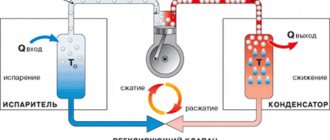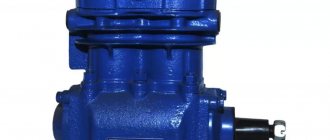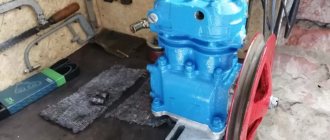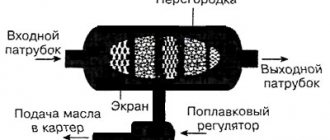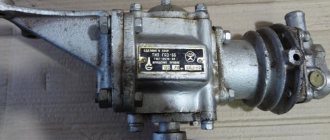Driving up to the garage one evening to park my car for the night, I was quite surprised to see a GAZ-52 model “truck” next to the garage.
I admit, I thought that they had long been supplanted by KamAZ trucks. But the truck looked quite good and even rattled. Under the hood, a neighbor in the garage, whom everyone simply calls Vasilyevich, was enthusiastically tinkering with something. He was a driver all his working life. He drove trucks, transported sand, crushed stone and building materials. And even now, being retired, he earns extra money by delivering peat to summer residents. Work, as he himself says, has become difficult due to an occupational joint disease. Vasilievich told me that he was working on a truck, or rather its engine. The story of an experienced mechanic seemed interesting to me and, with the approval of the master, I recorded it on my phone’s voice recorder and present it to you in the form of a short summary.
Homemade compressor - do it yourself
A compressor in the garage will always come in handy: pump up the wheels, paint them, “blow out” any parts, etc. Somehow I came across a single-cylinder compressor for a GAZ 66, an electric motor and a pair of receivers; I took the main ideas from the Internet. Therefore, I will not dwell on the principle of operation (everything is clear), but I will only post a photo and a short description of a homemade compressor for the garage . Receivers Two scuba tanks turned up by chance, which gave birth to the idea of building a compressor.
There are two drain valves at the bottom to drain condensate. On the right receiver there is an outlet valve, on the left there is a hose for connecting the containers to the compressor. I attached three wheels, weak, but enough to move around the garage, the top one with a turning axle. The wheels are taken from an old medical cart. devices.
Crankcase for a homemade compressor The GAZ 66 compressor was missing a crankcase cover, so I had to make a homemade one. I used a pipe sector with a diameter of 300 mm and a thickness of 5 mm. The edges of the sector were bent and leveled into a plane, and a 25X25 mm corner was welded to the ends. I cut off the excess corner. I drilled a hole in the bottom of the lid and installed a drain plug (10 mm bolt). I made guides for fastening from a 30x50 mm corner.
Manifold for instruments The receivers did not have additional holes for installing instruments (pressure gauge, emergency sensor). I thought for a long time about what to make a manifold from to install them on the pipeline. The idea arose to use the old VAZ clutch master cylinder. At first glance, everything is simple - weld two fittings and that’s it. But I was faced with the fact that it is impossible to make a high-quality weld, the metal from which the cylinder is made contains a lot of carbon. It “boils” during electric welding, welded it in several layers, filled it with glue from the inside to seal it. Later, this technology did not justify itself, and the collector was replaced by the GAZ-66 receiver, which has enough holes for instruments.
DIY compressor layout. Electric motor 1.5 kW, three-phase 220/380, 1500 rpm. installed on skids, it can be moved to tension the belt. secured with 4 M10 bolts. The compressor is mounted on skids with crankcase cover bolts.
Starting capacitors of a homemade compressor For the operation of such an engine, according to calculations, it is necessary to run 152 μF and release 250 μF, but it turned out to be sufficient for operation and starting at a pressure of up to 4 ATM C = 106 μF. But if the pressure is higher, then it is necessary to add a starting capacitor. I estimate that at a pressure of about 8 ATM, the standard power will be 1.2 kW, at 4-5 ATM it will be lower. Conclusion: the capacitor capacity I selected is sufficient. Capacitors of different types for breakdown voltage 500-630V are placed in boxes around the engine. The boxes are fixed to the frame and covered with a steel casing. The capacitor housings are insulated from the compressor housing with rubber gaskets. Gas station 10A was used for switching on. Connection to the network is carried out using a 3-wire circuit (the housing is connected to ground). The picture shows a homemade air filter. Made from a bottle of injector cleaner and a coffee can, with mesh and foam inside.
Compressor drive and cooling. A VAZ 2101 belt is used for the drive. The drive pulley is homemade, the driven pulley is from a ZIL 130 compressor. For cooling, a VAZ 2121 fan is placed on the compressor axis on top of the pulley and centered with a washer. The drive is protected by a casing.
Crankcase lubrication and ventilation. To improve lubrication of the crank mechanism, three holes are drilled in the connecting rod and bearings. The central channel of the crankshaft is connected to the container (GCS tank of a VAZ car) with a flexible oil-resistant hose. Excess oil enters it; when the compressor is running, oil can also be added. A special feature of the GAZ 66 compressor is that it is single-cylinder; during operation, the pressure in the crankcase changes, which is not desirable. I got rid of the shortcoming: I drilled a hole in the body, cut an M10 thread, screwed in a fitting and connected it to the oil tank. I enlarged the hole in the tank lid to 8mm and installed a rubber membrane with slots.
General view of the compressor.
All parts are covered with shields made of 1.5 mm steel. That's all. The idea arose to add a box to save space in the garage, of which there is never too much.
Place for tools. An aluminum box was attached to the top of the engine and the “battery” of capacitors. I plan to store tools and accessories in it. Seen in the photo at the beginning of the article.
Source
GAZ-66 compressor design
Before considering the main features that the GAZ 66 compressor pulley has, it is necessary to become more familiar with this important unit. It is a piston type, equipped with a single cylinder and allows for efficient air circulation. The compressor is equipped with an air cooling system, which prevents it from overheating during intensive operation. Thanks to the tire inflation system, it is possible to continue driving the vehicle until it becomes possible to eliminate the fault in comfortable conditions.
It should be noted that the characteristics of the GAZ 66 air compressor, as well as its design, differ significantly and depend on the specific modification of the vehicle. The standard versions of the car - 66, as well as 66-03 are not equipped with a pressure control system, which affected the design of the element.
The compressor used as part of such a system has an unloading cylinder in the threaded hole of the head, while the standard version uses a conventional plug instead. Considering the design of this element in more detail, it is advisable to note several main components at once:
- crankshaft, connecting rod, belt;
- piston, cylinder and its head;
- power fork, clutch, pulley;
- crankcase, seal and other elements.
This unit is distinguished by its reliability and long service life, subject to timely maintenance in accordance with the manufacturer’s recommendations.
Maintenance
When planning to maintain the compressor performance of such a car at the proper level, it is strongly recommended to carry out preventive manipulations aimed at maintaining the optimal technical condition of the unit. It is recommended to regularly check the tension of the compressor belts, which will prevent more serious damage.
Other steps you should take:
- control the correct position of the pump, which determines the correct oil level in the pump tank;
- inspect the main components for various mechanical damage and signs of wear;
- repair and maintenance require lubricating friction-prone elements—the “pin”—as well as the connecting rod with clean engine oil.
Such manipulations will allow you to maintain the operating condition of the unit, and will also allow you to promptly identify and eliminate more serious faults.
Diesel engines installed on GAZ 66 by the factory
By 1993, the Gorky Automobile Plant launched a new line for the production of diesel engines GAZ 542 and GAZ 544. The four-cylinder GAZ 544 was installed on the GAZ 3306 and GAZ 66 cars. This engine was air-cooled and had a power of 85 hp.
Diesel engine GAZ 5441
In 1995, the plant mastered modification of the GAZ 5441 engine with turbocharging, its power was increased to 115 hp. With. In 1999, production of the GAZ 66 ceased, and by the same time the line at the Gorky Automobile Plant for the production of diesel engines ceased to exist. These motors were considered unprofitable.
Characteristics of the GAZ-66 compressor
One of the main advantages is its excellent performance characteristics, which allow it to effectively perform the assigned tasks. Among them, the following indicators deserve mention:
- cylinder size - 6 cm;
- system volume - 107 cm3;
- efficiency - 116 l/min;
- power - 1.22 kW;
- element cooling - air type;
- drive type - belt;
- shaft rotation indicators are 2000-2500 rpm.
The product is manufactured by the fuel and lubricants plant; new elements are provided with a six-month warranty. After this period, various malfunctions may appear in the device, which can most easily be eliminated using a special repair kit containing all the necessary components.
Technical characteristics of GAZ 5441
• Maximum power – 115-117 hp. With. (according to various sources) the number of revolutions at rated power is 2800 per minute; • Number of cylinders – four, arranged in one row; • Engine volume – 4.15 l; • Torque (MAX) – 39 kgf•m; • Compression ratio – 16; • Standard piston diameter – 105 mm; • Piston stroke – 120 mm; • Type – turbocharged, air cooled; • Ventilation – open type; • The order of fuel supply to the internal combustion engine cylinders is 1-3-4-2; • Diesel fuel consumption is about 17 liters per 100 km.
Basic faults
There are several breakdowns that can significantly worsen the performance of the compressor or lead to its complete failure. Among them, the most common problems deserve mention, which include:
- decreased productivity;
- element overheating;
- oil release;
- increased noise during operation.
Each of these cases requires separate consideration, since it can be caused by various reasons. When power is reduced, problems are most often caused by air leaks in the system, clogged filter elements, and weak belt tension.
Overheating of the compressor can be caused by the lubrication system in the presence of contaminants, as well as the formation of carbon deposits in the piston system. No less often you have to deal with oil leakage, which occurs due to excessive wear of the piston ring seals, spring mechanism, and oil drainage channels. A knocking sound in the system occurs when components are worn excessively.
Recommendations for choosing a compressor model
When deciding which compressor to buy for your garage, you should take into account that the connecting rod-piston group of an oil compressor has a significantly longer service life than that of an oil-free compressor.
In addition to the main characteristics of the compressor - performance and operating pressure, it is also necessary to take into account the requirements imposed by garage conditions. This is due to the lack of free space and the state of the electrical network. For garages, cottages and other household needs, it is recommended to use household compressors with low electric motor power. This is due to the fact that in most garages, and even in summer cottages, electrical networks are in very poor condition. Sometimes even a low-power household compressor does not have enough voltage to achieve the required pressure, for example, 6 atmospheres.
An example of a suitable device is a household coaxial compressor with a power of approximately 2.5 kW, equipped with a 50 liter receiver. It can be used for almost all types of painting. An example of compressors of this class can be chosen, for example, model GM50300 from the Italian company Fiac with a 50 liter receiver and a suction capacity of 300 liters per minute.
Compressors of another series from Fiac are equipped with a V-shaped 2-cylinder compressor head, a 50 l receiver and have a suction capacity of 400 l/min. For example, model VX5040. A similar model, the Corsair 402M compressor from Fini, has a 25 liter receiver and a similar V-shaped 2-cylinder compressor head. These models require a high quality electrical network.
If you use a compressor every day, you should buy a more efficient device with a receiver volume of more than 50 liters. One of the possible options is a professional axial 2-cylinder compressor Remeza SB 4/S50 or SB 4/S100 jointly produced in Italy and Belarus.
The proposed models have a suction capacity of about 280 l/min and a receiver volume of 50 and 100 l, respectively. These models are very popular among garage painters with constant volumes of work.
Autoclub GAZ 52
GAZ-52 is one of the most famous Soviet trucks that belonged to the family of medium-duty vehicles of the 3rd generation of the Gorky Automobile Plant. Serial production of these legendary trucks began in 1958 - the last modification of the GAZ-52-04 rolled off the factory assembly line in 1989 (according to other sources, this happened in 1992). From 1958 to 1959 the car was produced under the symbol GAZ-52F, from 1966 to 1975 as GAZ-52-03, from 1975 to 1989 as GAZ-52-04. The people called the beloved, unpretentious domestically produced truck GAZ-52 nothing less than the “workhorse” of the economy of the Soviet Union. In total, a little more than 1 million trucks were produced.
Initially, the load capacity of the GAZ-52 was at around 2.5 tons - a little later this figure increased to 3.5 tons. The car was equipped with a unified cabin, like the GAZ-53 model. Despite the use of many common parts, the GAZ-52 and GAZ-53 still differed from each other in their wheel rims: the rims of the GAZ-52 and its various modifications had 6 ventilation holes and had narrower tires. In case of damage, the disks were replaced with new ones without much effort.
It is impossible not to note the wide range of GAZ-52 trucks: flatbed trucks GAZ-52-01 and GAZ-52-02 with 2 wheelbase options (3300 and 3700 mm, respectively). 1959 - the 1st batch of the GAZ-52F chassis was produced. 1961 - the beginning of production of the GAZ-52-03, equipped with a cabin from the GAZ-53A. In 1975, the GAZ-51A, which came off the factory assembly line, was replaced by a similar-sized truck, the GAZ-52-04, which was visually a vehicle on the GAZ-51 chassis and with a cab from the GAZ-53A.
Modifications GAZ-52-05, GAZ-52-08 and GAZ-52-09 are taxis designed for cargo and passenger transportation. It should be noted that the GAZ-52-09 was equipped with special equipment for operating on liquefied petroleum gas (LPG); A-76 gasoline was used as backup fuel. Among other things, the production of the GAZ-52-06 truck tractor, created to work with a semi-trailer weighing 4 tons, was launched. To operate on LPG (liquefied petroleum gas), the GAZ-52-07 modification was converted on the basis of the GAZ-52-04. GAZ-52 dump trucks were made at the Saransk Automobile Plant.
During the existence of the Soviet Union, the GAZ-52 and its various modifications were exported to countries that were part of the bloc of socialist powers. Mostly the “workhorse” of the Soviet economy was supplied to the GDR, Hungary, Czechoslovakia, Poland, Yugoslavia, Finland, Cuba, Vietnam, North Korea, Laos and Mongolia. Despite the fact that a sufficient amount of time has passed since the official cessation of serial production of this truck (more than 20 years), in certain regions of the Russian Federation you can still find perfectly functioning representatives of the 3rd generation of GAZ vehicles.
DIY garage compressor
Some specialists who have experience in making various devices on their own can make a homemade compressor for the garage and save money on purchasing a serial compressor.
As a basis for a homemade design, you can take a compressor from a GAZ-66 or ZIL-130 car, an electric motor and a couple of receivers. The compressor with the bottom cover removed is installed through a paronite gasket on a fragment of a channel 20-25 cm wide. The engine is similarly installed in milled grooves to create the required tension on the drive belt. Large cross-section belts should be avoided, as they take a lot of power from an already fairly low-power engine, especially one operating on one phase.
The electric motor is selected based on needs. For a 220V network, its minimum power should be 1.5 kW (1420 rpm), and the gear ratio should be selected 1:3. As engine power increases, the gear ratio decreases and compressor performance increases.
Optimal for a 220 V network is the use of a 2.2 kW motor. For a 3-phase power supply (380 V), the motor power may be less. For example, a 1.1 kW engine operating at a gear ratio of 21:8 = 2.6 at the power limit is capable of producing a pressure of 8 atmospheres and a productivity of 260 l/min.
Maintenance of a garage compressor during operation
Careful and regular maintenance of the compressor will extend the life of the unit and avoid breakdowns. It is recommended to carry out the following preventive measures.
Periodically clean or replace the filter. A non-woven material resembling a padding polyester is used as a filter. If the compressor is located in the same room where spray painting is being done, the filter often becomes clogged with sticky paint particles, which subsequently dry into the filter material and reduce its throughput.
This filter must be replaced with a new one.
Experienced garage technicians will improve their compressors by installing automotive-type air filters on them, which have much less resistance to the intake air and have better filtering qualities.
Such an upgraded filter increases the service life of the compressor, since it achieves a higher quality of filtration of abrasive particles contained in the air. As a result, the piston pair wears less and the service life of the compressor increases. Car filters are freely sold.
- Periodic oil change. Use only synthetic compressor oil for this;
- Periodic draining of condensate from the receiver. For this purpose, a special valve is provided at the bottom of the receiver. Before opening the valve, be sure to relieve the pressure in the receiver;
- Periodic cleaning of the electric motor and compressor cylinder from dust and dirt, which significantly impairs the cooling of working units.
After completing work, be sure to release the compressed air from the receiver, in which the compressed air should not be stored for a long time.
Modifications to the GAZ-52 engine
The following methods of struggle can be proposed. A lean mixture - here I propose a different ignition system: a thyristor, for a higher voltage. The ignition coil operates in a different mode and heats up less, despite more powerful impulses and additional leanness of the mixture at high speeds. Increasing the engine operating temperature to 90-95 degrees through a thermostat. As a result, oil consumption virtually disappears. The gasoline from the oil is all evaporated, and the oil becomes the viscosity it should be. The degree of combustion of gasoline increases, especially for 92 and 95, which is specific to us. From 76 it rises with poorly flammable additives - for example, diesel fuel. If the oil level is rising, it is much worse than if it is slowly falling. To organize oil cooling, there is a simple and slightly more complicated option. The first is to simply install an oil cooler from ZIL between the pump and the centrifugal cleaner - for the summer. There is another option to avoid reducing oil pressure by filtering and cooling it. This can be achieved by parallel supply of oil through the filter and radiator instead of a pressure sensor (through a tee). At the same time, we throttle the main flow by inserting a tube of 8 millimeters of internal cross-section into the filter pipe (for motors with a disposable filter in a tin housing). We put a copper coil in the crankcase of the oil system, and we supply water into it after the stove and have thermal stabilization of the oil to 110-115 degrees. In winter this will provide heating, in summer - light cooling.
In general, you need to climb into the crankcase, check the shaft journals to see if there are “foot wrappers” as thick as a candy wrapper. Enough mileage for 1000 kilometers. In general, for 2-4 days of fiddling, unless, of course, “pitfalls” are revealed.
